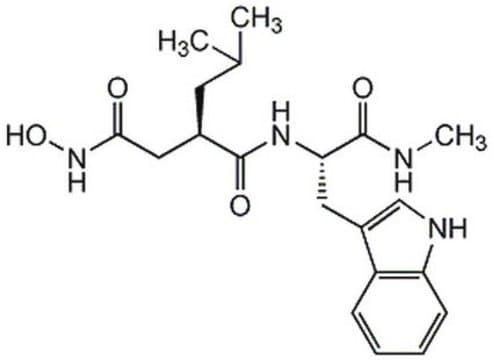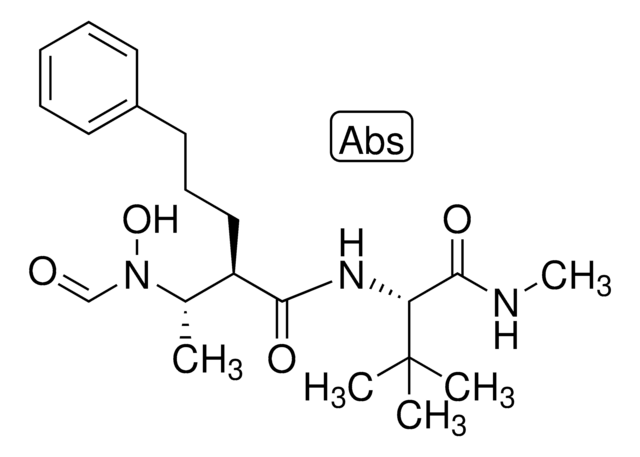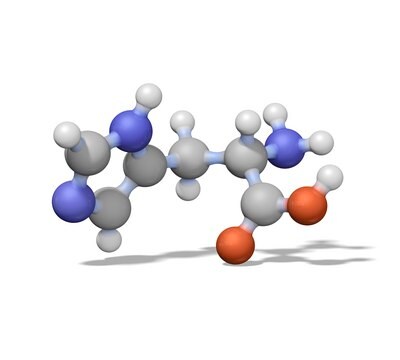565788
β-Secretase Inhibitor IV
≥98% (HPLC), solid, β-secretase inhibitor, Calbiochem®
Sinonimo/i:
β-Secretase Inhibitor IV, BACE Inhibitor C3
Scegli un formato
CHF 273.00
Scegli un formato
About This Item
CHF 273.00
Prodotti consigliati
Nome del prodotto
β-Secretase Inhibitor IV, β-Secretase Inhibitor IV, CAS 797035-11-1, is a cell-permeable inhibitor that binds to BACE-1 active site and blocks its proteolytic activity (IC₅₀ = 15 nM for human BACE-1).
Livello qualitativo
Saggio
≥98% (HPLC)
Stato
solid
Produttore/marchio commerciale
Calbiochem®
Condizioni di stoccaggio
OK to freeze
protect from light
Colore
white
Solubilità
DMSO: 100 mg/mL
Condizioni di spedizione
ambient
Temperatura di conservazione
2-8°C
Stringa SMILE
[S](=O)(=O)(N(C)c1cc(cc(c1)C(=O)N[C@H](C)c4ccccc4)C(=O)N[C@H]([C@H](O)CNC3CC3)Cc2ccccc2)C
InChI
1S/C31H38N4O5S/c1-21(23-12-8-5-9-13-23)33-30(37)24-17-25(19-27(18-24)35(2)41(3,39)40)31(38)34-28(16-22-10-6-4-7-11-22)29(36)20-32-26-14-15-26/h4-13,17-19,21,26,28-29,32,36H,14-16,20H2,1-3H3,(H,33,37)(H,34,38)/t21-,28+,29-/m1/s1
VPNIQGRFZCTBEZ-SPTGULJVSA-N
Descrizione generale
Azioni biochim/fisiol
BACE-1 human
Confezionamento
Attenzione
Ricostituzione
Altre note
Stachel, S.J., et al. 2004. J. Med. Chem.47, 6447.
Note legali
Codice della classe di stoccaggio
11 - Combustible Solids
Classe di pericolosità dell'acqua (WGK)
WGK 1
Punto d’infiammabilità (°F)
Not applicable
Punto d’infiammabilità (°C)
Not applicable
Certificati d'analisi (COA)
Cerca il Certificati d'analisi (COA) digitando il numero di lotto/batch corrispondente. I numeri di lotto o di batch sono stampati sull'etichetta dei prodotti dopo la parola ‘Lotto’ o ‘Batch’.
Possiedi già questo prodotto?
I documenti relativi ai prodotti acquistati recentemente sono disponibili nell’Archivio dei documenti.
Active Filters
Il team dei nostri ricercatori vanta grande esperienza in tutte le aree della ricerca quali Life Science, scienza dei materiali, sintesi chimica, cromatografia, discipline analitiche, ecc..
Contatta l'Assistenza Tecnica.








